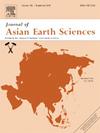晚第四纪气候变化和新构造对西北喜马拉雅马坎达河谷河流沉积和切割的影响
IF 2.4
3区 地球科学
Q2 GEOSCIENCES, MULTIDISCIPLINARY
引用次数: 0
摘要
构造和地表过程塑造了地球,喜马拉雅山脉是研究河流动力学与活动构造关系的关键区域。本研究以喜玛拉雅西北部以季风为主的马坎达河谷为研究对象,旨在揭示河流地貌和沉积历史,阐明季风变化与构造活动的相互作用。通过详细的野外测绘、沉积学测量和光学激发发光(OSL)测年,我们确定了至少五个主要的沉积阶段(>;45至38 ka、>; 27-23 ka、~ 17-12 ka、10-5.8 ka和3.4-3 ka),它们具有间歇性的切口阶段。这些阶段反映了印度夏季风(ISM)强度的变化,与更新世-全新世过渡期间的全球气候事件一致。地貌、沉积学和年代学分析显示,在45 ka至38 ka期间,扇指带与河流相交织,显示出一个高能环境和强季风。末次盛冰期(~ 25 ka)的切口反映了ISM的减弱,减少了沉积物通量,而快速沉积(~ 17-12 ka, 10-5.8 ka)对应了ISM的增强。我们估计在7 ka的时间里,沿高通量线的平均隆升率为4.4±0.4 mm/年,区域比较证实了气候的一致性。高频振荡重新激活的证据与记录的构造事件一致,然而,ISM分块作用显著影响了马坎达河谷的沉积和切割。本文章由计算机程序翻译,如有差异,请以英文原文为准。

Influence of late Quaternary climate change and Neo-tectonic on fluvial aggradation and incision in the Markanda valley, NW Himalaya
Tectonics and surface processes shape the Earth, and the Himalayas are a key region for studying the relationship between fluvial dynamics and active tectonics. Our study focuses on the monsoon-dominated Markanda River Valley, in NW Himalaya, aiming to reveal the river geomorphology and sedimentation history and elucidate the interactions between monsoonal variability and tectonic activity. Through detailed field mapping, sedimentological measurements and Optically Stimulated Luminescence (OSL) dating, we identified at least five major aggradation phases (>45 to 38 ka, >27–23 ka, ∼17–12 ka, 10–5.8 ka and 3.4–3 ka) with intermittent incision phases. These phases are the reflection of the changes in the strength of the Indian Summer Monsoon (ISM), aligning with global climatic events during the Pleistocene-Holocene transition. Geomorphological, sedimentological, and geochronological analyses reveal fan inter-fingering with fluvial facies from > 45 ka to 38 ka, indicating a high-energy environment and strong monsoons. Incision during the Last Glacial Maximum (∼25 ka) reflects weakened ISM, reducing sediment flux, while rapid aggradation (∼17–12 ka, 10–5.8 ka), corresponds to strengthened ISM. We estimate an average uplift rate of 4.4 ± 0.4 mm/year along the HFT over 7 ka and the regional comparisons confirm the climatic coherence. The evidence of HFT reactivation aligns with documented tectonic events, however, ISM fractionations significantly influenced aggradation and incision in the Markanda Valley.
求助全文
通过发布文献求助,成功后即可免费获取论文全文。
去求助
来源期刊

Journal of Asian Earth Sciences
地学-地球科学综合
CiteScore
5.90
自引率
10.00%
发文量
324
审稿时长
71 days
期刊介绍:
Journal of Asian Earth Sciences has an open access mirror journal Journal of Asian Earth Sciences: X, sharing the same aims and scope, editorial team, submission system and rigorous peer review.
The Journal of Asian Earth Sciences is an international interdisciplinary journal devoted to all aspects of research related to the solid Earth Sciences of Asia. The Journal publishes high quality, peer-reviewed scientific papers on the regional geology, tectonics, geochemistry and geophysics of Asia. It will be devoted primarily to research papers but short communications relating to new developments of broad interest, reviews and book reviews will also be included. Papers must have international appeal and should present work of more than local significance.
The scope includes deep processes of the Asian continent and its adjacent oceans; seismology and earthquakes; orogeny, magmatism, metamorphism and volcanism; growth, deformation and destruction of the Asian crust; crust-mantle interaction; evolution of life (early life, biostratigraphy, biogeography and mass-extinction); fluids, fluxes and reservoirs of mineral and energy resources; surface processes (weathering, erosion, transport and deposition of sediments) and resulting geomorphology; and the response of the Earth to global climate change as viewed within the Asian continent and surrounding oceans.
 求助内容:
求助内容: 应助结果提醒方式:
应助结果提醒方式:


